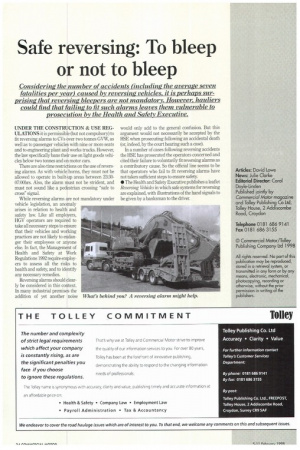Safe reversing: To bleep or not to bleep
Page 36

If you've noticed an error in this article please click here to report it so we can fix it.
Considering the number of accidents (including the average seven fatalities per year) caused by reversing vehicles, it is perhaps surprising that reversing bleepers are not mandatory. However, hauliers could find that failing to fit such alarms leaves them vulnerable to prosecution by the Health and Safety Executive.
UNDER THE CONSTRUCTION & USE REGULATIONS it is permissible (but not compulsory) to fit reversing alarms to CVs over two tonnes GVW, as well as to passenger vehicles with nine or more seats and to engineering plant and works trucks. However, the law specifically bans their use on light goods vehicles below two tonnes and on motor cars.
There are also time restrictions on the use of revers• ing alarms. As with vehicle horns, they must not he allowed to operate in built-up areas between 23:3007:00hrs. Also, the alarm must not be strident, and must not sound like a pedestrian crossing "safe to cross" signal.
While reversing alarms are not mandatory under vehicle legislation, an anomaly arises in relation to health and safety law. Like all employers, HGV operators are required to take all necessary steps to ensure that their vehicles and working practices are not likely to endanger their employees or anyone else. In fact, the Management of Health and Safety at Work Regulations 1992 require employers to assess all the risks to health and safety, and to identify any necessary remedies.
Reversing alarms should clearly be considered in this context. In many industrial premises the addition of yet another noise
would only add to the general confusion. But this argument would not necessarily be accepted by the HSE when prosecuting following an accidental death (or, indeed, by the court hearing such a case).
In a number of cases following reversing accidents the HSE has prosecuted the operators concerned and cited their failure to voluntarily fit reversing alarms as a contributory cause. So the official line seems to be that operators who fail to fit reversing alarms have not taken sufficient steps to ensure safety
• The Health and Safety Executive publishes a leaflet Reversing Vehicles in which safe systems for reversing are explained, with illustrations of the hand signals to be given by a banksman to the driver.








































































































